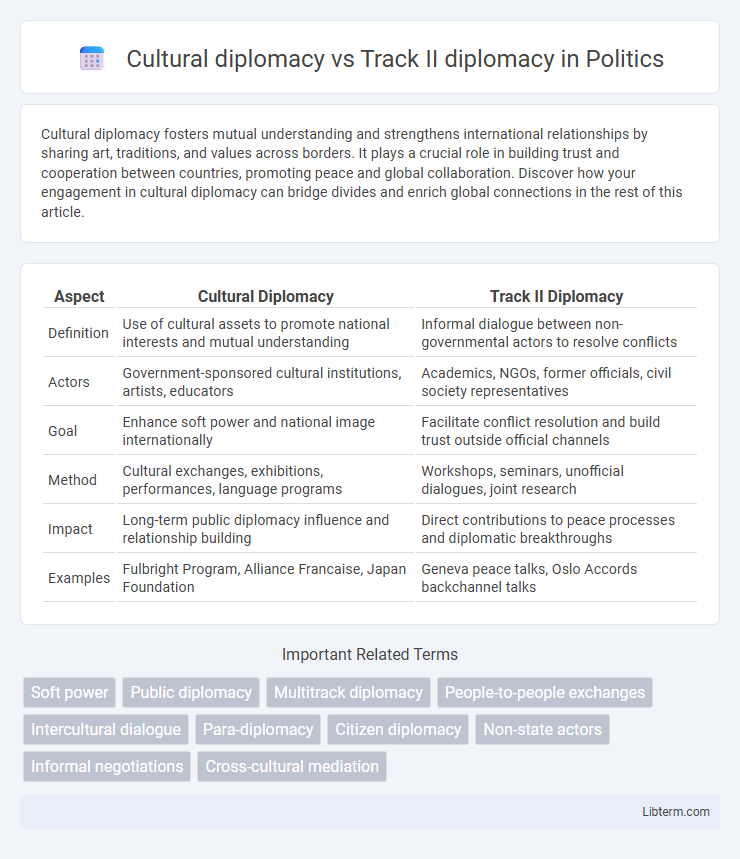Cultural diplomacy fosters mutual understanding and strengthens international relationships by sharing art, traditions, and values across borders. It plays a crucial role in building trust and cooperation between countries, promoting peace and global collaboration. Discover how your engagement in cultural diplomacy can bridge divides and enrich global connections in the rest of this article.
Table of Comparison
| Aspect | Cultural Diplomacy | Track II Diplomacy |
|---|---|---|
| Definition | Use of cultural assets to promote national interests and mutual understanding | Informal dialogue between non-governmental actors to resolve conflicts |
| Actors | Government-sponsored cultural institutions, artists, educators | Academics, NGOs, former officials, civil society representatives |
| Goal | Enhance soft power and national image internationally | Facilitate conflict resolution and build trust outside official channels |
| Method | Cultural exchanges, exhibitions, performances, language programs | Workshops, seminars, unofficial dialogues, joint research |
| Impact | Long-term public diplomacy influence and relationship building | Direct contributions to peace processes and diplomatic breakthroughs |
| Examples | Fulbright Program, Alliance Francaise, Japan Foundation | Geneva peace talks, Oslo Accords backchannel talks |
Introduction to Cultural Diplomacy and Track II Diplomacy
Cultural diplomacy promotes mutual understanding and strengthens international relations through the exchange of arts, education, and cultural programs, engaging non-governmental actors to foster long-term goodwill. Track II diplomacy involves unofficial dialogue and problem-solving activities between non-state actors such as academics, NGOs, and former officials to address conflicts and build trust outside formal government channels. Both forms of diplomacy complement traditional statecraft by creating informal platforms for communication and collaboration, enhancing global peace efforts.
Defining Cultural Diplomacy: Tools and Objectives
Cultural diplomacy employs arts, education, and heritage as tools to foster mutual understanding and strengthen international relations between countries. It aims to promote national values and cultural exchange to build long-term goodwill and influence public perception abroad. Distinct from Track II diplomacy, which involves unofficial dialogue and problem-solving among non-government actors, cultural diplomacy emphasizes state-led initiatives rooted in cultural engagement and soft power projection.
Understanding Track II Diplomacy: Actors and Mechanisms
Track II diplomacy involves non-governmental actors such as academics, retired officials, and civil society representatives who engage in informal dialogue to resolve conflicts and build trust outside official government channels. These mechanisms facilitate open communication, foster mutual understanding, and explore innovative solutions without the constraints of formal diplomatic protocol. Cultural diplomacy, in contrast, primarily uses cultural exchanges and shared artistic experiences to promote mutual respect and peaceful international relations.
Historical Evolution of Diplomatic Approaches
Cultural diplomacy and Track II diplomacy have evolved through distinct historical trajectories reflecting changing international relations paradigms. Cultural diplomacy, with roots in public diplomacy efforts of the early 20th century, emphasizes the exchange of ideas, arts, and cultural values to foster mutual understanding, as seen in initiatives like the U.S. government's cultural programs during the Cold War. Track II diplomacy emerged more prominently during the Cold War era as informal, unofficial dialogue facilitated by academics and non-state actors to complement formal diplomatic negotiations, particularly in conflict resolution contexts.
Key Differences: Cultural Diplomacy vs Track II Diplomacy
Cultural diplomacy emphasizes the use of cultural exchanges, art, education, and heritage to foster mutual understanding and build long-term relationships between nations. In contrast, Track II diplomacy involves unofficial, informal dialogues between non-governmental actors like academics, retired officials, and civil society representatives aimed at conflict resolution and policy recommendations outside formal government channels. While cultural diplomacy focuses on soft power and public diplomacy to shape perceptions, Track II diplomacy targets behind-the-scenes negotiation and problem-solving to complement official diplomatic efforts.
Role of Non-State Actors in Both Paradigms
Non-state actors play a pivotal role in both cultural diplomacy and Track II diplomacy by facilitating communication and fostering mutual understanding beyond formal government channels. In cultural diplomacy, artists, educators, and cultural institutions promote shared values and narratives that build people-to-people connections, enhancing soft power influence. Track II diplomacy relies on think tanks, NGOs, and religious groups to engage in informal dialogue aimed at conflict resolution and trust-building, supplementing official diplomatic efforts.
Success Stories: Impactful Case Studies
Cultural diplomacy has achieved significant success through initiatives like the US-Soviet cultural exchanges during the Cold War, fostering mutual understanding and easing tensions. Track II diplomacy, exemplified by the Oslo Accords negotiations between Israel and Palestine, facilitated confidential dialogue that paved the way for official peace talks. Both approaches demonstrate how non-official engagements can complement formal diplomacy by building trust and promoting conflict resolution.
Challenges and Limitations of Each Approach
Cultural diplomacy often faces challenges such as cultural misunderstandings and limited reach beyond elite or urban populations, restricting its ability to influence broader public opinion. Track II diplomacy struggles with legitimacy and the lack of formal authority, which can hinder the implementation of agreed-upon solutions in official diplomatic channels. Both approaches require sustained engagement and resource investment to overcome skepticism and ensure meaningful impact in conflict resolution and international relations.
Interplay and Synergy Between Cultural and Track II Diplomacy
Cultural diplomacy and Track II diplomacy intersect through the promotion of mutual understanding and trust-building in international relations, often operating beyond official governmental channels. Cultural exchanges, such as art exhibitions or educational programs, complement Track II initiatives by fostering grassroots dialogue that can influence formal negotiations. The synergy between these approaches enhances conflict resolution and cooperation by blending emotional resonance with strategic problem-solving.
Future Trends in Global Diplomatic Engagement
Cultural diplomacy and Track II diplomacy are evolving as complementary tools shaping future global diplomatic engagement by fostering mutual understanding beyond formal government channels. Cultural diplomacy leverages arts, heritage, and educational exchanges to build long-term relationships and soft power, while Track II diplomacy involves informal dialogue among non-state actors to resolve conflicts and facilitate cooperation. Emerging trends emphasize digital platforms, public-private partnerships, and cross-cultural collaboration to enhance the impact and reach of these diplomatic strategies in a multipolar world.
Cultural diplomacy Infographic

 libterm.com
libterm.com